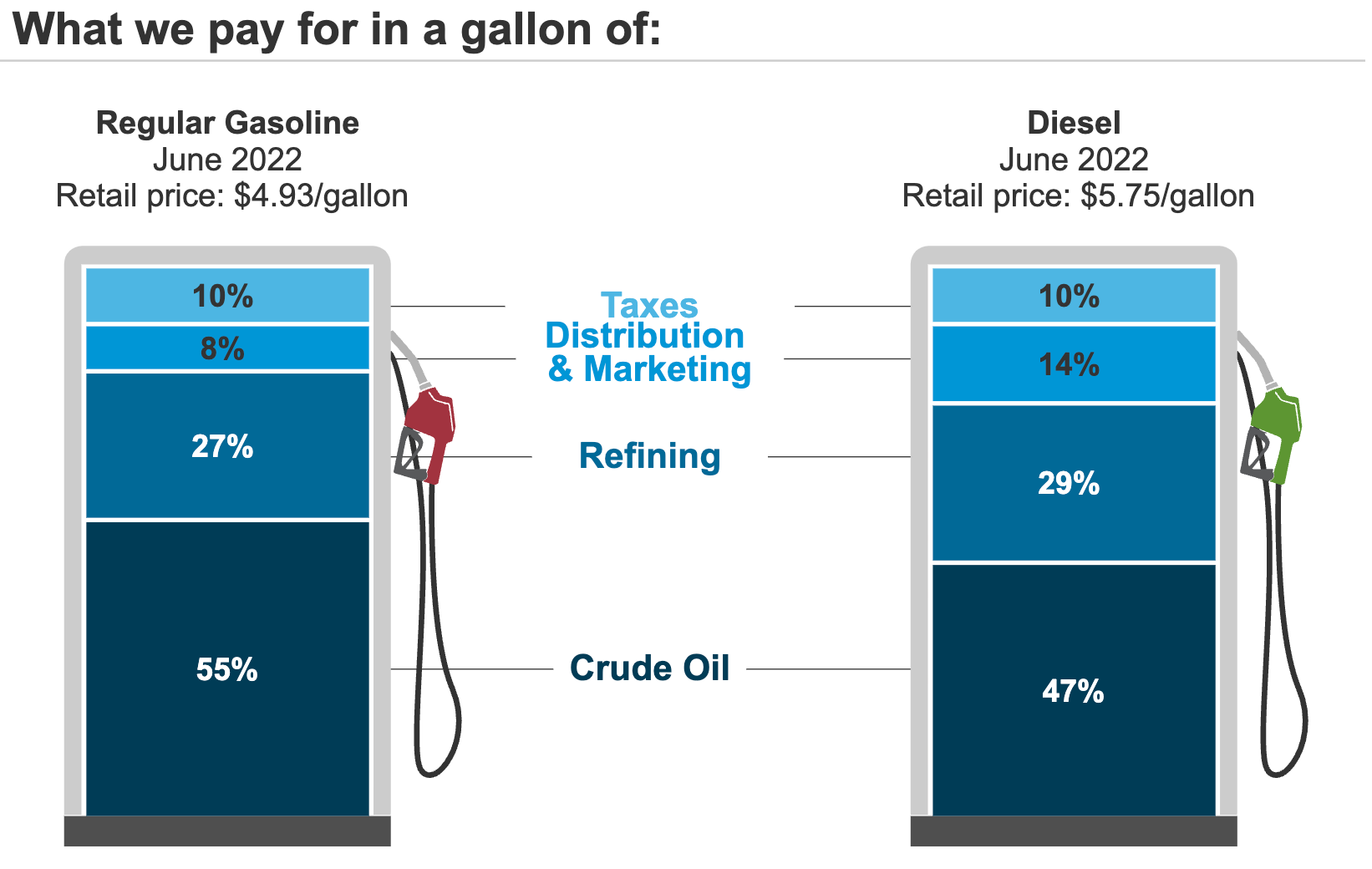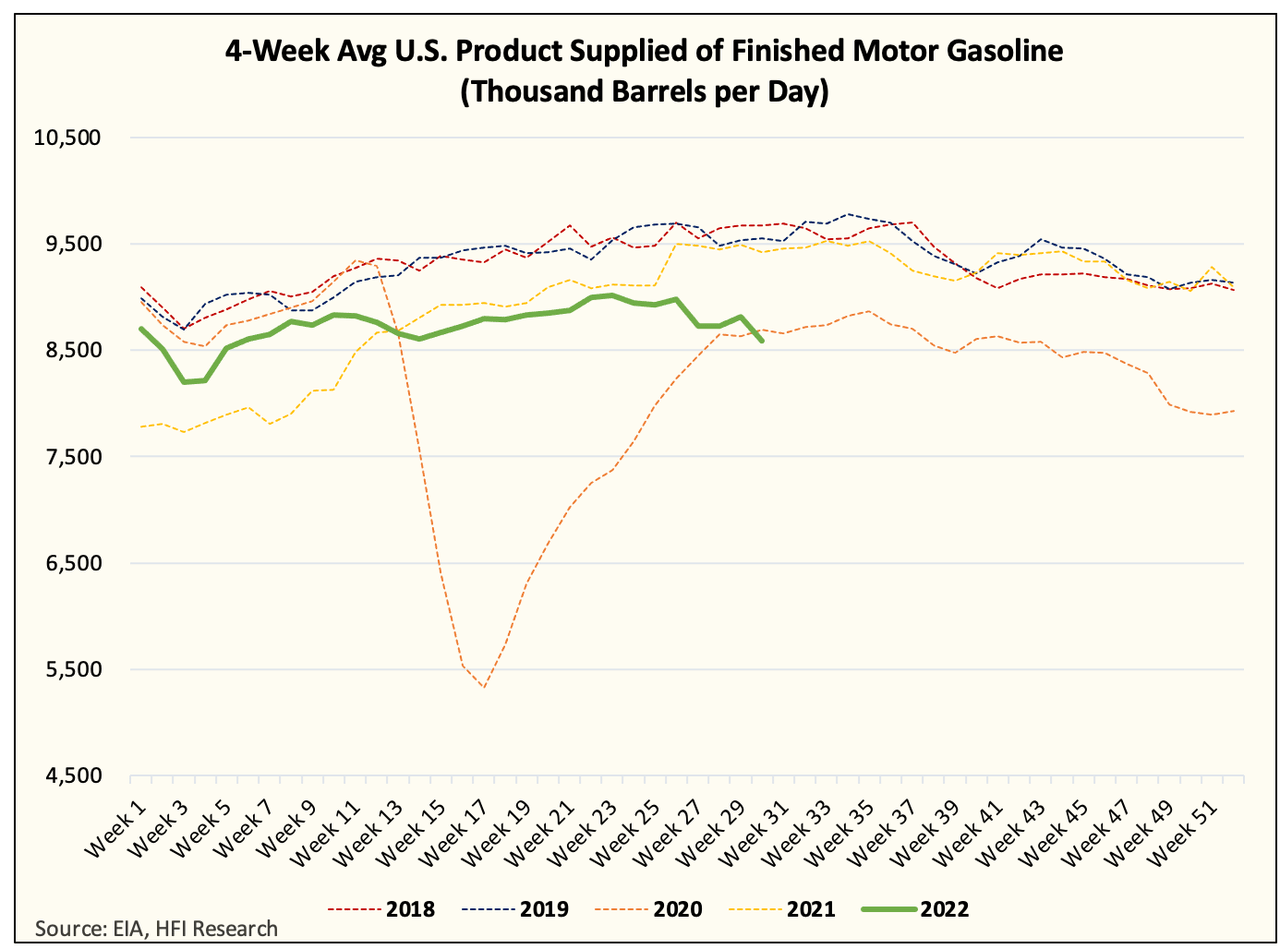U.S. gasoline demand on a 4-week average basis fell below 2020 pandemic levels based on Energy Information Administration data for product supplied of motor gasoline. High gasoline prices due to President Biden’s anti-oil and gas policies have had a major impact on gasoline and diesel demand. Those policies as well as lower demand from China related to Covid lockdowns (July 2022 demand was about 10 percent lower than last year) and recession worries have lowered oil prices which are a major contributing factor to gasoline and diesel prices. According to EIA, 55 percent of the gasoline price is based on the price of oil.

The graph below shows the demand destruction resulting from high gasoline prices based on EIA product supplied data. According to preliminary data on same-store gasoline sales from OPIS, American drivers purchased 8 percent less gasoline in the week ended July 30 compared with the same time last year. Since hitting a record national average of $5 a gallon this summer, gasoline prices have dropped about 95 cents a gallon and could fall below $4 a gallon on a national average basis later this month. Even with that decline, they are still 87 cents higher than a year ago and about $1.40 higher than when Biden took office and began stopping or slowing oil and gas operations.

While the downward trend in gasoline prices is encouraging, it may not last. Many of the factors that limited supplies and spurred record gasoline prices still remain, such as limited refining capacity. U.S. refineries are working all out, running at over 90 percent capacity utilization to meet summer demand but they will need to slow down for required maintenance and possibly go offline if they fall in the path of severe storms during hurricane season. The U.S. refining sector has been hit hard by closures and conversions to biofuel facilities where the profits are greater due to generous federal and state subsidies. For example, in California, refiners yield $3.70 more per gallon from state and federal governments from converting to biofuel production. Around 3 million barrels a day of global refining capacity have closed during the COVID pandemic and about 1 million barrels a day of that was in the United States. It is very unlikely that any new U.S. refinery will open due to federal regulations.
The Biden Administration wants to take credit for lower gasoline prices, pointing to increased production expectations from the Organization of the Petroleum Exporting Countries and its allies, OPEC+, and oil releases from the U.S. Strategic Petroleum Reserve (SPR)—the latest release totaling about 1 million barrels a day since the end of April. But that release is set to end in the coming months, and Biden has promised to refill SPR—designed for emergency purposes, which is currently at 65 percent of its capacity. Refilling it will increase demand requiring more production.
And, to Biden’s dismay due to all his begging, OPEC+ has agreed only to add 100,000 barrels of oil a day to global supplies in September — a very small amount, particularly compared to Biden’s SPR releases and OPEC’s announced increases for July and August of 650,000 barrels per day. The paltry increase in OPEC+ output — less than one-tenth of 1 percent of global oil demand, the smallest increase in memory — appears to be a snub of Mr. Biden, who traveled to Saudi Arabia seeking additional production from major oil producers in the Middle East to reduce gasoline prices.
Conclusion
President Biden wants to take credit for the lower gasoline prices despite the fact that they are still $1.40 a gallon higher than when he took office and that he hasn’t changed any of the policies he’s instituted that have brought the higher gasoline prices to Americans. Gasoline has become so expensive many people have reduced their use of it, making them victims of scarcity and high prices.
Biden’s Treasury Department claims that the Administration’s SPR releases and coordinated releases by allies decreased gas prices by up to 40 cents a gallon, using demand elasticities from other studies. But, all the department succeeded in doing is indicating that greater global oil supply should lower prices. There are additional constraints and factors on the system including refining capacity, sanctions on Russia, China lockdowns, recession worries and Americans’ response to record high prices that need to be considered. Yes, greater supply would help. But, Biden refuses to take the steps to allow more U.S. oil production by holding Federal lands captive and threatening additional regulations and costs that will continue to curtail production. Since the United States is the world’s swing producer accounting for 80 percent of the world’s marginal increase in production between 2010 and 2019, Biden’s assaults on domestic production only limit world output.



